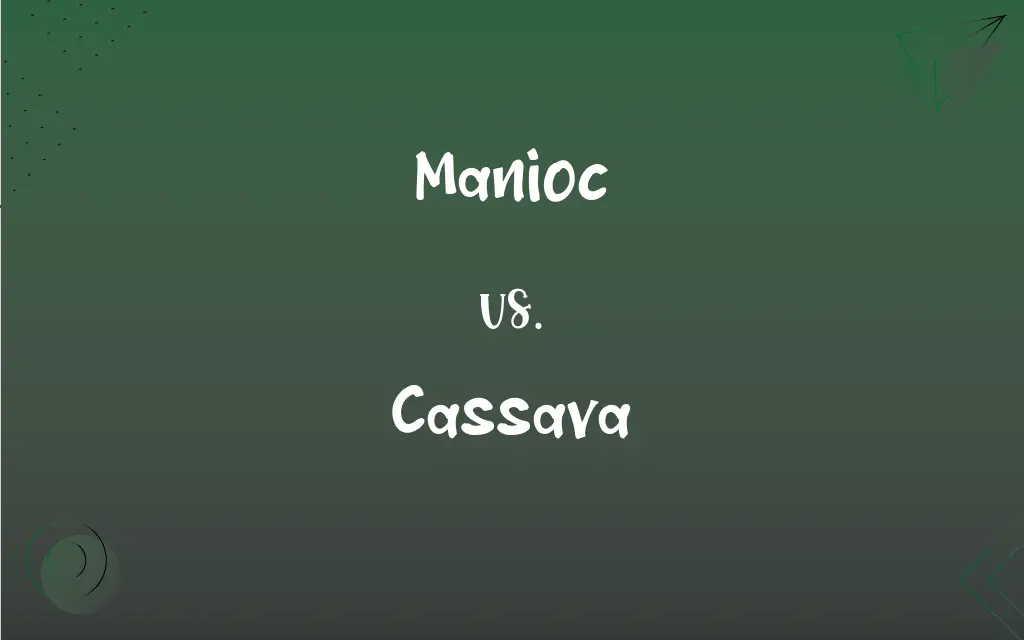Manioc vs. Cassava: What's the Difference?
By Harlon Moss & Janet White || Updated on May 20, 2024
Manioc and cassava are two names for the same root vegetable, primarily grown in tropical regions for its starchy roots used in cooking and industry.

Key Differences
Manioc and cassava are terms used interchangeably to refer to the same plant, scientifically known as Manihot esculenta. This root vegetable is a staple food in many tropical countries, valued for its high carbohydrate content.
Manioc is more commonly used in French-speaking regions, reflecting its French and Latin American culinary ties. It is often utilized in traditional dishes such as manioc flour-based bread and porridges. Cassava, on the other hand, is the term predominantly used in English-speaking regions, including Africa and parts of Asia. Cassava is integral in making products like tapioca and is used widely in both culinary and industrial applications.
Manioc roots are typically processed to remove toxic compounds before consumption, ensuring safety. Cassava undergoes similar processing methods to make it safe for eating. Both terms refer to the same process of peeling, grating, soaking, and cooking the roots to neutralize the natural cyanide present in the plant.
Manioc is versatile, used in a variety of traditional dishes, including boiled, fried, or as flour. Cassava is equally versatile and is a key ingredient in many global cuisines, often appearing in soups, stews, and snacks. Despite regional terminological differences, manioc and cassava are essentially the same plant with similar culinary and industrial uses.
Comparison Chart
Common Name
French-speaking regions
English-speaking regions
ADVERTISEMENT
Scientific Name
Manihot esculenta
Manihot esculenta
Culinary Uses
Bread, porridge
Tapioca, soups, stews
Processing
Remove toxic compounds
Remove toxic compounds
Versatility
Boiled, fried, flour
Soups, stews, snacks
Manioc and Cassava Definitions
Manioc
A tropical root vegetable high in starch.
Manioc is a staple in many tropical diets.
ADVERTISEMENT
Cassava
Can be processed into flour for baking.
Cassava flour is often used in gluten-free recipes.
Manioc
Known as yuca in some regions.
In the Caribbean, manioc is often referred to as yuca.
Cassava
The English term for the tropical root vegetable manioc.
Cassava is widely consumed in Africa and Asia.
Manioc
Commonly used in French and Latin American cuisines.
She made a traditional dish using ground manioc flour.
Cassava
Integral to many traditional dishes worldwide.
Cassava is a key ingredient in many Brazilian dishes.
Manioc
See cassava.
Cassava
Used to make tapioca and other products.
Tapioca pudding is made from cassava starch.
Manioc
The tropical plant Manihot esculenta, from which cassava and tapioca are prepared.
Cassava
A shrubby tropical American plant (Manihot esculenta) widely grown for its large, tuberous, starchy roots.
Manioc
(uncountable) Cassava root, eaten as a food.
Cassava
Contains natural toxins that must be removed before eating.
The cassava roots were carefully prepared to ensure they were safe to eat.
Manioc
(uncountable) A food starch prepared from the root.
Cassava
The root of this plant, eaten as a staple food in the tropics only after leaching and drying to remove cyanide. Cassava starch is also the source of tapioca. In both senses also called manioc, yuca.
Manioc
The tropical plants (Manihot utilissima, and Manihot Aipi), from which cassava and tapioca are prepared; also, cassava.
Cassava
Manioc (Manihot esculenta), a tropical plant which is the source of tapioca.
Manioc
A starch made by leaching and drying the root of the cassava plant; the source of tapioca; a staple food in the tropics
Cassava
Tapioca, a starchy pulp made with manioc roots.
Manioc
Cassava root eaten as a staple food after drying and leaching; source of tapioca
Cassava
A shrubby euphorbiaceous plant of the genus Manihot, with fleshy rootstocks yielding an edible starch; - called also manioc.
Manioc
Cassava with long tuberous edible roots and soft brittle stems; used especially to make cassiri (an intoxicating drink) and tapioca
Cassava
A nutritious starch obtained from the rootstocks of the cassava plant, used as food and in making tapioca.
Manioc
Often processed to remove toxins before consumption.
The manioc was soaked overnight to remove its natural toxins.
Cassava
A starch made by leaching and drying the root of the cassava plant; the source of tapioca; a staple food in the tropics
Manioc
Versatile in preparation methods such as boiling and frying.
The fried manioc chips were a delicious snack.
Cassava
Cassava root eaten as a staple food after drying and leaching; source of tapioca
Cassava
Any of several plants of the genus Manihot having fleshy roots yielding a nutritious starch
FAQs
Are manioc and cassava the same plant?
Yes, they are the same plant, scientifically known as Manihot esculenta.
Where is manioc commonly used?
Manioc is commonly used in French-speaking regions and Latin America.
How is cassava processed for safety?
Cassava undergoes similar processing, including peeling, soaking, and cooking.
What is cassava?
Cassava is the English term for the same tropical root vegetable known as manioc.
Where is cassava commonly used?
Cassava is commonly used in English-speaking regions, including Africa and parts of Asia.
What is the main nutrient in manioc?
The main nutrient in manioc is starch.
What are the culinary uses of cassava?
Cassava is used to make tapioca, soups, stews, and snacks.
What is manioc?
Manioc is a tropical root vegetable high in starch, commonly used in French-speaking regions.
Is cassava known by any other names?
Yes, cassava is sometimes referred to as yuca or manioc.
Can manioc be eaten raw?
No, manioc must be processed to remove toxins before consumption.
How is manioc processed for safety?
Manioc is peeled, grated, soaked, and cooked to remove natural toxins.
What are the culinary uses of manioc?
Manioc is used to make bread, porridge, and can be boiled or fried.
What traditional dishes use manioc?
Traditional dishes using manioc include bread and porridge.
What is the main nutrient in cassava?
The main nutrient in cassava is also starch.
What traditional dishes use cassava?
Traditional dishes using cassava include tapioca pudding and various stews.
What products are made from manioc?
Products like manioc flour and various traditional dishes are made from manioc.
What products are made from cassava?
Cassava is used to make tapioca, flour, and various culinary products.
Is manioc known by any other names?
Yes, manioc is also known as yuca in some regions.
Is manioc used in gluten-free recipes?
Yes, manioc flour is often used in gluten-free recipes.
Can cassava be eaten raw?
No, cassava also needs to be processed to remove toxins before it is safe to eat.
About Author
Written by
Harlon MossHarlon is a seasoned quality moderator and accomplished content writer for Difference Wiki. An alumnus of the prestigious University of California, he earned his degree in Computer Science. Leveraging his academic background, Harlon brings a meticulous and informed perspective to his work, ensuring content accuracy and excellence.
Co-written by
Janet WhiteJanet White has been an esteemed writer and blogger for Difference Wiki. Holding a Master's degree in Science and Medical Journalism from the prestigious Boston University, she has consistently demonstrated her expertise and passion for her field. When she's not immersed in her work, Janet relishes her time exercising, delving into a good book, and cherishing moments with friends and family.































































